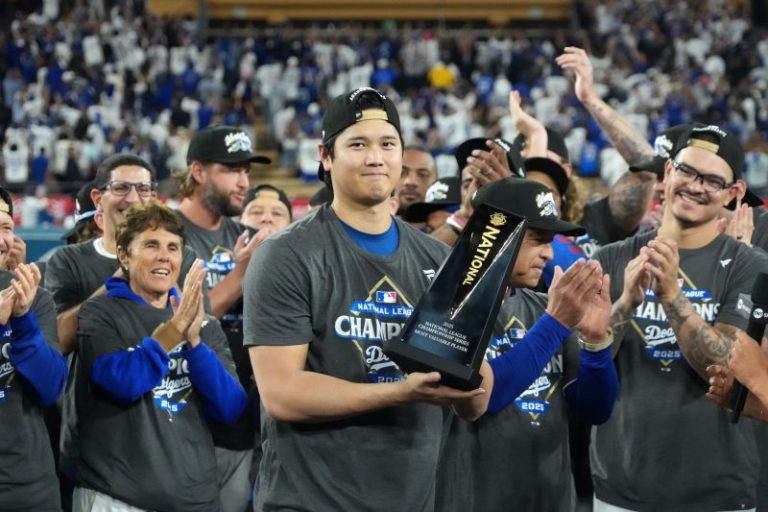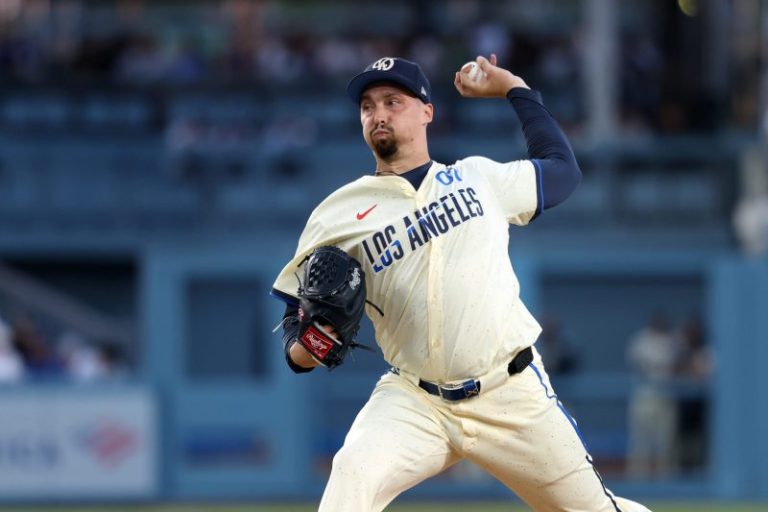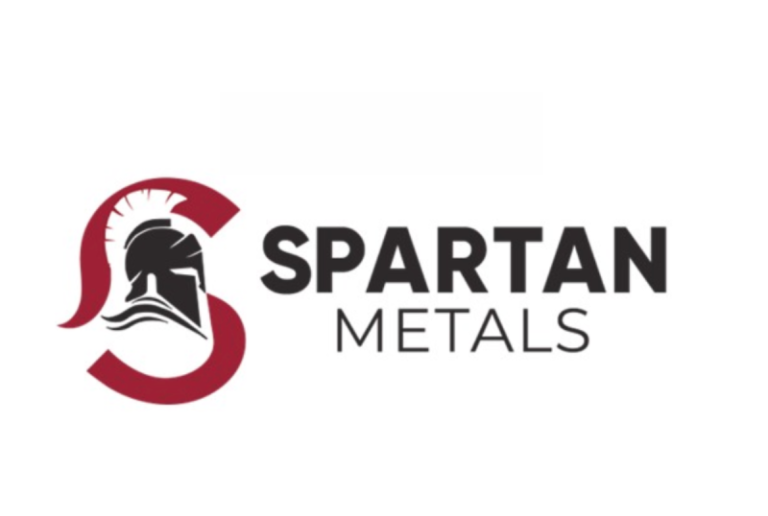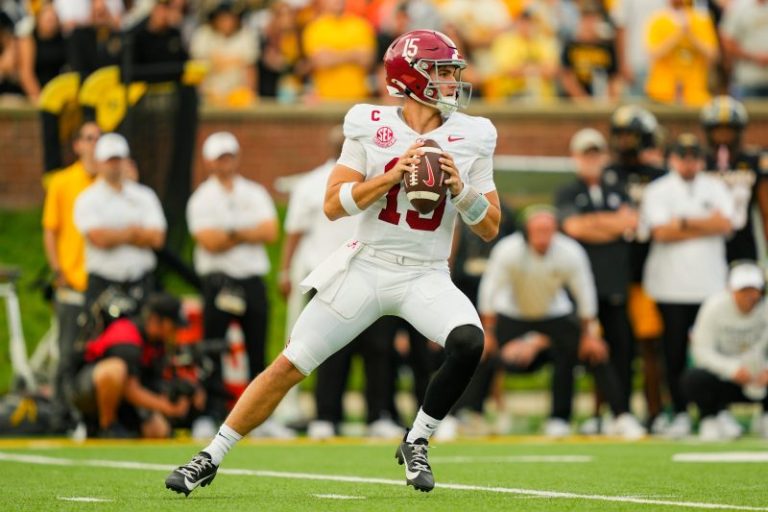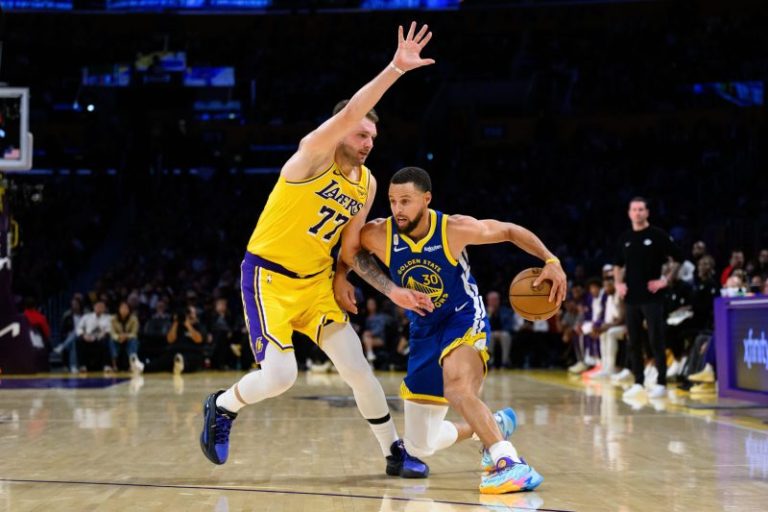The halfway point of the 2025 NFL season is inching closer. Entering Week 8, most teams league-wide have a solid idea of their playoff chances this season. For those without aspirations of playing January football, it’s never too early to look ahead to the 2026 NFL Draft.
This upcoming draft class has seen plenty of change at the top with plenty of risers and many fallers. As the weeks wear on, some positions are surprisingly full of early-round talent.
Linebackers and wide receivers may have seen the most improvement over the course of the year. There are a couple of locks at each position with many more making a case for first-round consideration.
Quarterbacks will grab the headlines but don’t expect a class like what we saw in 2024. We have four passers in our latest first-round mock draft. Indiana’s Fernando Mendoza leads the way at No. 1 overall to the winless New York Jets.
Three other teams find a potential quarterback of the future, including an AFC division leader. Here’s our latest predictions for the first round of the 2026 NFL Draft with the order provided by Tankathon:
2026 NFL mock draft
1. New York Jets: QB Fernando Mendoza, Indiana
We’re keeping it straightforward to start things off. Mendoza’s been the top draft-eligible quarterback this season and continues to impress with his mix of timing, accuracy and mobility. He’ll thrive in a timing-based offense and operate like a point guard to distribute the ball to the Jets’ skill position players.
2. Miami Dolphins: OT Spencer Fano, Utah
It was between two trench players and we opted for the offensive line. Fano is a Day 1 starter at right tackle for the Dolphins, who should immediately help in the run game. His movement skills overall are some of the best in the class and he plays with a violent streak as a blocker. He’ll likely need to bulk up a bit to stick at tackle long-term but his high floor is hard to beat.
Other positions were in consideration but it felt too early for the secondary or offensive skill position players on the board.
3. New Orleans Saints: Edge Rueben Bain Jr., Miami
New Orleans happily selects arguably the top prospect in the entire draft class at No. 3. Bain entered the season as a likely first-round player thanks to his size (6-foot-3, 275 pounds) and power. He’s progressed even more in 2025 as an every-down edge rusher who can set the edge in run defense and use his power to overwhelm blockers as a pass rusher.
Spencer Rattler struggled against Chicago but he’s played well enough for us to hold off on mocking a quarterback to New Orleans for now.
4. Tennessee Titans: WR Jordyn Tyson, Arizona State
The Titans need more reinforcements on offense and it came down to help in the trenches or with a difference-making skill position player. There’s a lot of unknown with the Titans as they enter the post-Brian Callahan era. Namely, who the next coach and offensive play caller will be.
In any case, we settled on the top wide receiver of the class in Tyson. The Arizona State product regularly creates separation thanks to his short-area quickness and impressive route running. He’s not a burner but has a WR1 ceiling for 2025 No. 1 overall pick Cam Ward.
5. Baltimore Ravens: DT Peter Woods, Clemson
Injuries have hit the Ravens’ defense hard this season. Nnamdi Madubuike’s season-ending injury was one of the more impactful for the unit as a whole. It’d be a surprise to see the Ravens picking in this range come April, but with the current board, Woods would be a great fit.
Some considered Woods the best prospect in the class entering the season. He’s alignment versatile thanks to his twitch and athleticism packed into a 6-foot-3, 315-pound frame.
6. Cleveland Browns: QB Dante Moore, Oregon
From one Duck to another. Cleveland selects a quarterback of the future in Moore, the strong-armed passer from Eugene. Moore took over for current Browns quarterback Dillon Gabriel for 2025 has proceeded to wow evaluators with his development. He’s long been considered a good deep ball passer but he’s improved underneath and as a scrambler.
He’s not the No. 1 QB in the class as of yet, though, because of his struggles against handling the pressure packages thrown at him by Indiana earlier in the college football season.
7. Las Vegas Raiders: OT Francis Mauigoa, Miami
The Raiders’ offense struggled immensely against Kansas City in Week 7. It’d be easy just to give them a quarterback here and consider everything fixed. But this offensive line needs help; it’s one of the worst units in the league.
Mauigoa’s been a right tackle for his career in Coral Gables but may line up at guard in the NFL. In either case, he’s an athletic mover at 6-foot-6 and 315 pounds whose experienced varied blocking concepts with the Hurricanes. He’ll be a strong run blocker immediately, helping create more space to maximize Ashton Jeanty and uplift the whole offense.
8. New York Giants: WR Makai Lemon, USC
Plenty of options are on the table for the Giants at No. 8. For this mock, we decided to give Malik Nabers a running mate in the wide receiving corps.
Lemon’s shot up draft boards this season behind his stellar play on the field. He’s primarily lined up in the slot and caught nearly 80% of his targets this season. His recent performance against Notre Dame (four catches for 76 yards) is dampened by a costly fumble but don’t be fooled. He’s the most reliable and productive slot wide receiver in the class.
9. Arizona Cardinals: LB Arvell Reese, Ohio State
This may seem a bit early for a linebacker and Cardinals fans may be right to be wary. The Isaiah Simmons experience wasn’t long enough ago to be forgotten.
But Reese is simply on another level as a prospect. He’s arguably the best linebacker prospect to come out of college in the last five years. He combines impressive size (6-foot-4, 243 pounds) and athleticism with the instincts to be a factor in coverage, pass rush and run defense. There just aren’t second-level players who move like him in the college ranks. He’d be a force multiplier for Jonathan Gannon’s defense.
10. Houston Texans: OT Kadyn Proctor, Alabama
Arguably, the biggest takeaway from the Texans’ “Monday Night Football” loss to the Seattle Seahawks is that the offensive line could not get movement up front in the run game. Houston desperately needs help up front and they go with the outlier Proctor here.
The Alabama left tackle has truly rare athleticism in a 6-foot-7, 360-pound frame. The Crimson Tide have used him as a receiver multiple times this season to utilize his skills in unique ways. He struggled with consistency to start the season. In Week 1 against Florida State, he allowed six pressures, three hurries, two quarterback hits and one sack. He’s cleaned things up since then, though, with seven pressures, six hurries, one quarterback hit and zero sacks in the next six games combined.
11. Cincinnati Bengals: S Caleb Downs, Ohio State
Cincinnati has multiple needs but arguably the biggest one is a difference maker on defense. Downs has a claim to the best prospect in the class regardless of position. He’s a rare talent at the position with the mix of size (6-foot, 205 pounds), athleticism and football IQ.
His elite processing abilities for the position make him an asset in coverage and run defense. Creative defensive coordinators can deploy him all over the defense and he’s versatile enough to fit multiple roles. He’s got Pro Bowl potential in year one and could be the catalyst to turn the secondary around in Cincinnati.
12. Washington Commanders: TE Kenyon Sadiq, Oregon
Washington’s aging roster could use younger talent at plenty of spots. Offensive skill position seems the most pressing of them all to help franchise quarterback Jayden Daniels. The offensive line looks pretty set with a good mix of talent and depth so the franchise opts to go with Sadiq.
The Oregon tight end is the clear-cut No. 1 prospect at the position with the size (6-foot-3, 245 pounds) and long speed to be a matchup nightmare for most defenses. His elite athleticism makes him an even better fit in an NFL offense than college.
13. Dallas Cowboys: Edge Keldric Faulk, Auburn
Dallas’ defense has struggled to stop opposing pass offenses all season. Looking at the board and the roster, the team goes with the versatile Faulk to help address those issues.
The Auburn product provides inside-out versatility thanks to his impressive frame (6-foot-6, 285 pounds). That frame makes him a standout run defender already with the power to set the edge against tackles. His athleticism means there’s plenty of potential to tap into as a pass rusher. His skillset and size are reminiscent of Calais Campbell; all he needs is the coaching and refinement to maximize his gifts.
14. Los Angeles Rams (via Atlanta Falcons): QB Ty Simpson, Alabama
Simpson is making the most of his first season as a starter in Tuscaloosa. The Crimson Tide passer continued his rise last week against Tennessee and should be considered a first-round quarterback come April.
He’s performed well even when he‘s asked to attack defenses in different ways. He played well with an average depth of target (ADOT) of nearly 10 yards against Vanderbilt, per Pro Football Focus (PFF) data. A week later, he threw for three touchdowns with a 6.5-yard ADOT against Missouri and getting pressured 15 times. His main knock is a lack of experience, and Los Angeles could afford to sit him behind Matthew Stafford for a season before he takes over in 2027.
15. Minnesota Vikings: CB Jermod McCoy, Tennessee
Minnesota needs help in the secondary. As much as defensive coordinator Brian Flores can scheme up exotic looks that stress offenses, he needs more talent in the back end to handle the top offenses in the league.
Despite missing the 2025 season so far while recovering from an ACL tear in the offseason, McCoy has the claim as the top corner in the class with his size (6-foot, 195 pounds) and ball production. He’s best in zone coverage but is more than capable in press. His fluidity as an athlete makes him an ideal corner for disguising coverages.
16. Carolina Panthers: WR Carnell Tate, Ohio State
Carolina’s got a winning record for the first time since 2021 behind one of the best running games in the league and a defense punching well above its weight. So we’ve decided to boost the passing game again with another weapon for Bryce Young to throw to.
Tate stepped out of Emeka Egbuka’s shadow in 2025 and became one of the best wide receivers in college football. His passer rating when targeted is 148.2, per PFF data, and he’s thrived as a deep threat for the Buckeyes despite his lack of elite long speed. He’s averaging 17.3 yards per reception this season. Drop him opposite 2025 first-rounder Tetairoa McMillan, and the Panthers’ pass offense could take a step.
17. Kansas City Chiefs: RB Jeremiyah Love, Notre Dame
The Chiefs have the infrastructure and talent at key positions on both sides of the ball to simply take the best player available on the board and that’s certainly Love at this point.
Like Sadiq and Downs at their respective positions, Love is the clear-cut No. 1 running back in the class. He’s a true three-down player for Notre Dame with ideal contact balance paired with game-breaking speed. At 6-foot and 215 pounds, he’s built well to handle NFL contact and demands.
18. Chicago Bears: OT Caleb Lomu, Utah
Chicago’s gone with multiple offensive line combinations this season to put their best five on the field. Braxton Jones will be a free agent in 2026 and has been moved down the depth chart behind fellow 2026 free agent Theo Benedet.
Lomu needs more development than his Utah teammate Fano but he has the experience at left tackle and top-tier athletic abilities. His hand usage is improving quickly and his high floor as a pass protector is certainly a great start. He could make the transition from Jones or Benedet easier to handle in 2026.
19. Los Angeles Chargers: Edge T.J. Parker, Clemson
Los Angeles needs difference makers on defense. The Chargers’ staff is maximizing what it has but needs more young pieces to build around in order to take a step forward.
Parker could be that player. At 6-foot-3 and 265 pounds, he has both size and pass rush production that should translate to the NFL. He’s comfortable either rushing off the edge or with his hand down in a three-point stance. Speed-to-power makes Parker a threat to get to the quarterback at any time.
20. Cleveland Browns (via Jacksonville Jaguars): OL Gennings Dunker, Iowa
Both of Cleveland’s starting guards are hitting free agency in 2026. Joel Bitonio and Wyatt Teller are both over 30 and the Browns may want to turn over that talent up front as they welcome a new quarterback to the fold.
Dunker spent his college career at left tackle but he’ll be a guard at the NFL level. He’s a force in run blocking with the strength and attitude to knock defenders off their spot. He can operate in varied blocking schemes. His lack of elite lateral agility and arm length are what may keep him inside at the next level. He projects similarly to Buccaneers’ lineman Graham Barton.
21. Buffalo Bills: Edge LT Overton, Alabama
Buffalo invested in the later rounds on the defensive line in the 2025 NFL Draft and we have them doing that earlier on in this draft.
Overton brings elite speed off the edge in a 6-foot-5, 280-pound frame. Like Faulk, his size and athletic profile mean he can kick inside later to wreak havoc on guards and centers with his bend and powerful hands. At the very least, he’ll be a powerful edge-setter against the run.
22. Seattle Seahawks: IOL Olaivavega Ioane, Penn State
Seattle’s defense has become one of the best in the NFL as the 2025 season’s worn on. Rather than building on that strength, we’re opting to shore up the offensive line in front of Sam Darnold.
Among prospects who will project best on the interior in the NFL and played there in college, Ioane is the best. The Graham, Washington native would return to the Pacific Northwest as a plug-and-play starter at one of the guard spots. He’s a dependable pass protector and run blocker at 6-foot-3 and 334 pounds.
23. Los Angeles Rams: CB Mansoor Delane, LSU
Delane won’t wow teams with his combine numbers which may make him even more endearing to the Rams. The Tigers’ top cornerback lacks strength in his long frame at 6-foot-1 and 187 pounds but has been one of the best coverage players in college football this season.
Delane uses his football IQ, awareness and fluid athleticism to stay in the right place at the right time and cut off opposing wide receivers. He’s allowed just six receptions for 77 yards on 23 targets this season. Opposing quarterbacks have a 22.9 passer rating when targeting him, per PFF data.
24. Detroit Lions: CB Avieon Terrell, Clemson
Detroit continues to have injury woes – this year it’s in the secondary – so we’re opting to shore up the depth in the back end. Terrell, the younger brother of Falcons cornerback A.J. Terrell, is a bit smaller than most modern cornerbacks at 5-foot-11 and 180 pounds but plays much bigger.
He’s remarkably physical for his size and can fit in either zone or man schemes thanks to his elite athleticism and fluid change-of-direction ability. He can play aggressively but has the ability to recover and avoid getting burned by opposing receivers.
25. Pittsburgh Steelers: QB LaNorris Sellers, South Carolina
Pittsburgh can’t rely on Aaron Rodgers for the future. Considering their last late-first round pick at quarterback was Kenny Pickett, we have them going in a much different direction with Sellers.
The South Carolina passer is far from a finished product as a passer but possesses rare abilities as a runner. At 6-foot-3 and 240 pounds with a background in soccer, he attacks the open field in a way reminiscent of Cam Newton. Pittsburgh’s offensive line is fourth-best in the league in pressure rate allowed, per NFL Next Gen Stats. Sellers could grow into a better passer behind that safe offensive line.
26. Denver Broncos: DT A’Mauri Washington, Oregon
Denver built on a strength in going defense in Round 1 of the 2025 NFL Draft and they do the same again here. This time, they address the front.
Washington’s been one of the top surprises of the college football season. The 6-foot-3, 330-pound defensive tackle stepped into a bigger role to showcase his impressive athleticism and power, which translate well to the NFL level. He’d be a different type of interior rusher than what Denver has in-house but could add another wrinkle to one of the best defenses in the league.
27. Tampa Bay Buccaneers: Edge David Bailey, Texas Tech
Tampa Bay is second in the NFL in pressure rate (41.4%) but could always use more help off the edge for coach Todd Bowles’ scheme.
Bailey transferred from Stanford to Texas Tech this season and continued his torrid pace off the edge. He’d likely be confined to a designated pass rusher role early on at 6-foot-3 and 250 pounds. That’s not a huge knock on him, though. He leads college football in sacks with 11 and ranks third with 26 hurries. He’d be an immediate help off the edge on passing downs.
28. Philadelphia Eagles: DT Caleb Banks, Florida
Banks would’ve likely been a top-15 pick if not for a foot injury that cut his final college season short. But with a roster like Philadelphia’s, they can afford to have him bide his time and ease into a role as a rookie.
At 6-foot-6 and 334 pounds, he’d fit right in alongside Jalen Carter and offer the team a potential off-ramp should they decide against re-signing Jordan Davis in 2027. Banks has the size and athleticism to show flashes of dominance but needs the right environment to improve his consistency. In Philadelphia, he’ll have just that.
29. New England Patriots: WR Chris Brazzell II, Tennessee
New England needs to address the infrastructure around ascending quarterback Drake Maye. Given the board, skill positions have better prospects available than offensive line.
Brazzell could fit into multiple roles for the Patriots offense on a week-to-week basis. At 6-foot-5 and a fluid athlete, he could stress defenses vertically and be a contested-catch merchant. His short-area quickness and flexibility mean he can more than capably operate underneath.
30. San Francisco 49ers: WR Chris Bell, Louisville
San Francisco needs help on the offensive line, but given how hard the position was hit by injury in 2025, wide receiver could use some help as well. Ricky Pearsall has looked good when on the field, and Kyle Shanahan could use another young piece to build around.
Bell is one of the bigger receivers in the class at 6-foot-2 and 220 pounds but he has track speed to challenge defenses in a way that shows shades of A.J. Brown. He can create mismatches that Shanahan could exploit as the offense continues to evolve with Brock Purdy as the quarterback.
31. Dallas Cowboys (via Green Bay Packers): LB C.J. Allen, Georgia
Dallas addresses defense again with its second pick in the first round with the next-best player in a talented linebacker class.
Allen’s stout frame at 6-foot-1 and 235 pounds means he’ll be a solid fit in run defense but it’s his impressive athleticism that’ll make him stick as a coverage linebacker. He needs some refinement in that area but the tools are there. He’s shown growth in understanding opposing offenses that will likely continue at the NFL level.
32. Indianapolis Colts: CB Malik Muhammad, Texas
Indianapolis sits at the end of the first round thanks to one of the most productive, efficient offenses in the NFL this season. We’ll use their top resource in the draft to address defense.
Outside of Kenny Moore II in the slot, the Colts’ secondary could use more reinforcements. Muhammad processes the game well and knows where to be positioned in varied coverage assignments. On 18 targets in 2025, he’s allowed 11 receptions for just 75 yards, per PFF data. He’s versatile enough for coordinator Lou Anarumo to use him all over the formation.
This post appeared first on USA TODAY

